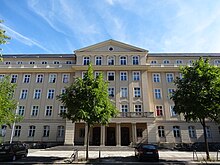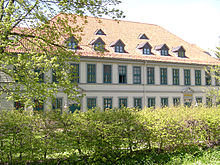Dormitory
A student residence (sometimes also called a student residence , student village , or student residence for short ) is accommodation for students . You can live here cheaply during your studies , mostly in small single rooms, studio apartments or in shared apartments .
In the USA and Great Britain , student accommodation is often integrated into an administrative-organizationally related campus . In the UK, dormitories are still common in some cases, while larger dormitory complexes are standard in the USA. In Germany and Austria there are numerous sponsoring associations of their own that rent out accommodation to students; the German student unions, for example, rent around 184,000 dormitory spaces alone (end of 2013).
history
Germany



In Germany, student residences are mostly run by the local student unions . But there are also many self-managed, private or church student residences. The largest contiguous residential complex run by a German student union is the student city of Freimann in Munich . The largest private, self-managed student residence hall in Germany is the Hans-Dickmann-Kolleg (“HaDiKo”) in Karlsruhe .
In Germany, around 10% of all students lived in dormitories in the 2012 summer semester. This is the lowest value since the surveys began in 1991 (then: 16%). This comparatively high value in 1991 was mainly due to the situation in the new federal states; There, the number of dormitory places has been significantly reduced since 1991 as part of modernization measures in which multi-bed rooms were converted into single rooms. In the old federal states, the share of dormitory users was already at a similar level in 1991 as in 2012. According to the social study by the German Student Union, dormitory use depends primarily on the availability of dormitory places. In Brandenburg, Bavaria and Baden-Württemberg, this type of living is proportionally the most widespread in a comparison of the federal states, with around 15%. In Hamburg, Berlin and Bremen therefore only home places for 5% of the students are offered, so mostly at their own homes or residential communities is avoided. The proportionate decline in student dormitories is mainly due to the fact that the number of students is growing much faster than the number of dormitory places. The social survey also shows that older students in particular prefer their own apartment.
Almost a tenth of students prefer dormitories to other types of housing, whereby the cost factor plays a role. Student residences are intended to provide social support for students who cannot find any other affordable accommodation. For inexpensive living space, private providers, for example in Berlin or Munich, also offer container villages as permanently installed dormitories for students. In the summer semester of 2012, students spent around 34% of their monthly income on housing, which corresponds to around 298 euros. Accommodation in dormitories is usually the cheapest option with an average rent of 240 euros.
Most student residences have been equipped with Internet connections since around the end of the 1990s .
Austria
In Austria, the home providers are mostly private organizations. Many of them have a close relationship with political parties, interest groups, regional authorities or church institutions. They work for the public benefit and are not for profit. Most home sponsors only operate one dormitory, but there are also home sponsors who run ten or more homes. In the 1997/1998 winter semester there were 192 student dormitories nationwide with 23,976 places, which were administered by 105 dormitories.
There are student residences in the university and technical college locations of Vienna , Graz , Salzburg , Innsbruck , Linz , St. Pölten , Leoben , Klagenfurt , Hagenberg im Mühlkreis , Dornbirn , Wiener Neustadt and Eisenstadt .

| The largest home carriers in Austria | Number of homes | Number of home places |
|---|---|---|
| Academic aid | 22nd | 3500 |
| STUWO non-profit student housing AG | 7th | 1925 |
| Austrian Young Workers Movement ( ÖJAB ) | 20th | 3800 |
| Austrian Student Promotion Foundation | 15th | 1999 |
| Board of Trustees Adolf Schärf Student Dormitories | 6th | 1623 |
| Economic aid to working class students | 9 | 852 |
| Economic aid federal states (total) | 24 | 3144 |
| As of 2001/02 and 2005/06, subsidiaries not included. | ||
According to the 2006 student social survey, 9.9 percent of students lived in student residences. Average housing costs throughout Austria are 232 euros (for comparison: students in shared flats: 277 euros, students with their own households: 347 euros).
In 1998, 11 percent of Austrian students were still living in student residences. Their monthly housing costs averaged 2690 Schillings (for comparison: students in shared flats : 3470 Schillings. Students with their own households: 4220 Schillings.).
Investment subsidies for student dormitories by the public sector are counted as “indirect student subsidies”.
Basic legal regulations for living in student dormitories have been laid down in the Student Dormitory Act (BGBl. 291/1986) since 1986.
North America
In North America, student residences are mostly operated directly by the universities. It is customary there that the length of residence is linked to the semester times. Outside of the semester, the accommodations are sometimes used for other purposes, for example as holiday accommodation. Double and triple rooms are far more common than single rooms. Most of the rooms do not have their own wet room. Often there are no kitchens at all. In many universities, students of different grades ( freshmen , sophomores , juniors and seniors) are housed in separate rooms, whereby the living comfort is usually higher towards the end of their studies than at the beginning.
"Room & Board" (dormitory and cafeteria ) is billed at a fixed price, in which student financing and funding in the United States is a significant factor in addition to tuition fees .
Web links
- Commons : Student residences in Germany - collection of pictures, videos and audio files
- Commons : Student residences in Austria - collection of pictures, videos and audio files
- The German Student Union on the subject of housing
- Student residences in Austria at studium.at
- Illustrated dormitory dictionary ( Memento from August 12, 2011 in the Internet Archive )
Individual evidence
- ↑ Reunion with old friends , in: Unicum , edition 11/2013, p. 10 f.
- ↑ a b c 20th Social Survey 2012, Chapter 11: Housing situation.
- ↑ HIS Institute for University Research: The Economic and Social Situation of Students in Germany 2012. Excerpt. , P. 32 ( PDF ).
- ↑ Freight containers become student apartments in Berlin. In: berlin.de. July 19, 2013, accessed August 20, 2019 .
- ↑ HIS Institute for University Research: The Economic and Social Situation of Students in Germany 2012. Excerpt. , P. 25 ( PDF ).
- ^ Dormitory of the Karlsruhe Institute of Technology (KIT) e. V. . The association's website, accessed March 8, 2016.
- ↑ At ÖJAB, the above figures (as of September 2011) also include 3 youth residences with 350 places that not only accommodate students, but also other young people, e.g. B. Apprentices and young workers.




